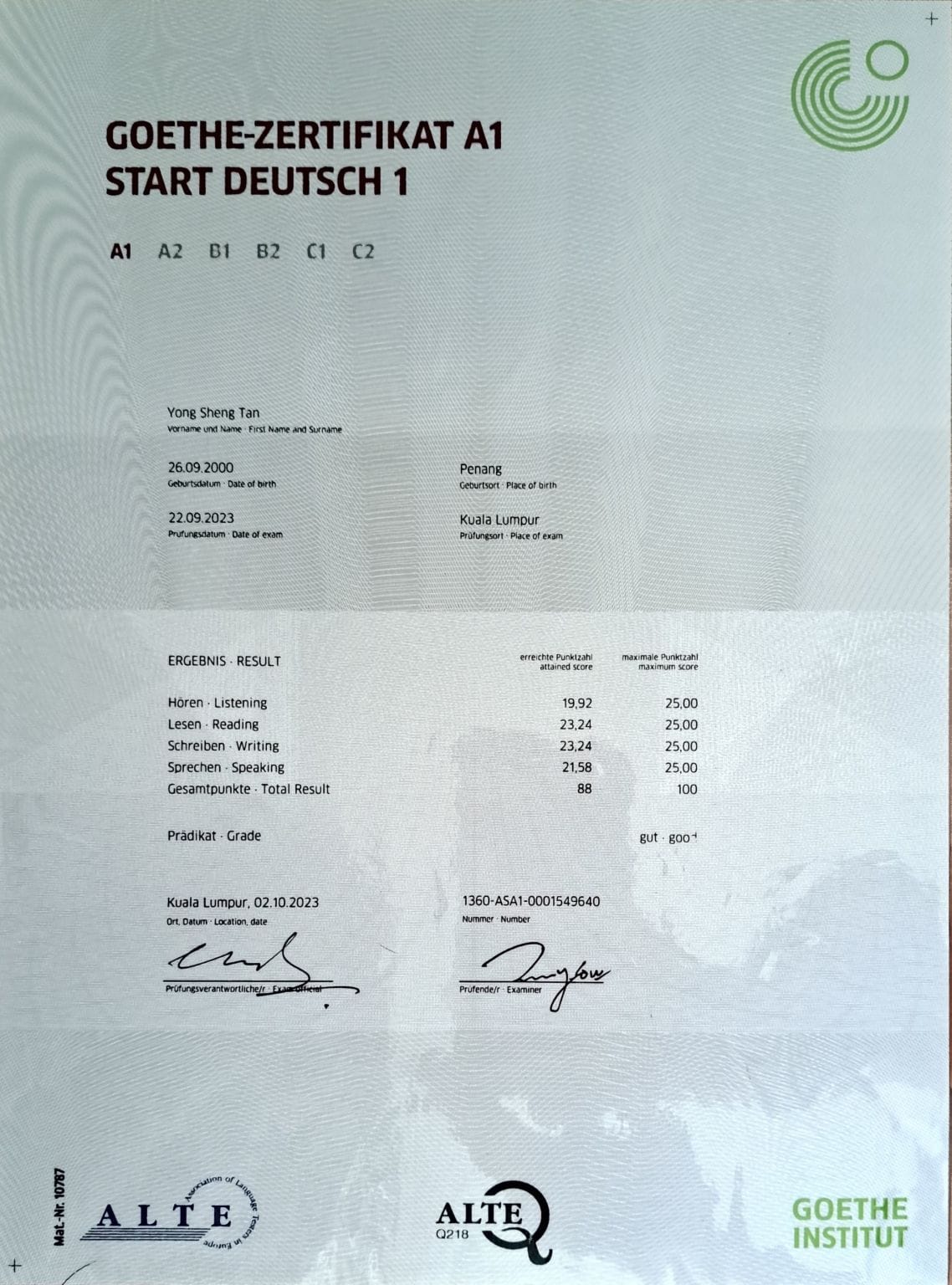
Geothe Zertifikat 4 All
Add a reviewOverview
-
Sectors Administrative Support
-
Posted Jobs 0
-
Viewed 338
Company Description
Ten Things You Learned About Kindergarden They’ll Help You Understand A1 Certificate Buy Experiences
A1 Certificate Updates and Common Issues
 As the global workforce expands and evolves the process of the process of ensuring compliance with international employment laws becomes more complex. Recent updates to A1 forms, along with common issues illustrate the importance of understanding these forms.
As the global workforce expands and evolves the process of the process of ensuring compliance with international employment laws becomes more complex. Recent updates to A1 forms, along with common issues illustrate the importance of understanding these forms.
If you’re traveling for business in many European countries A valid A1 certificate is required. But do you know when it’s needed and how to get one?
1. Getting Started
The A1 Certificate streamlines international work arrangements, offering a practical and legally sound option for employees and businesses that operate across borders. The certificate guarantees that workers are not liable to social insurance laws of more than one country, preventing excessive costs or administrative burdens. It is an obligation of law for any employee working in another EU country. However, it can be used by employees who travel to other countries for business purposes like attending meetings, conferences or fairs.
The steps to get an A1 certificate could differ from one country to the next however the basic steps are the same. Employees must first verify their eligibility, and then complete the appropriate form with the appropriate authority. The form includes the information about their home country, employer, and the destination country they will be working in. This form is typically the easiest to fill online. The employee is then required to complete the form and submit it along with required documents to the social security authorities in their home country.
Once the A1 certificate is issued, it is able to be used in all the countries of the European Union. However, there are a few simplified procedures for those who frequent travel to several EU countries. If an employee or self-employed person regularly pursues their work in three or more Member States They can apply for a permanent certificate that allows them to pay into the system in their home country for up to a year.
If you don’t have an A1 certificate prior to embarking for a trip related to work could be fined. This is especially true in France, Austria and Switzerland where the inspectors have recently announced a wave of inspections targeting businesses that don’t provide their employees with the proper documents. Local authorities may deny access to a construction site in the event that, for instance employees are sent there without an A1 certification. Employers and hosting firms that do not secure their employees A1 certificates be fined. This is why it is essential to begin the A1 certification process as soon as possible.
2. Documentation
The A1 certificate is a key piece of documentation needed by workers who travel frequently to various countries for work. The certificate proves that the worker is insured in their home country. This allows them to avoid paying social insurance premiums in other countries. This can save companies lots of money in the long term. It’s crucial that employers understand the documents that employees require to obtain this form.
To avoid penalties and fines, employees who travel for business have to carry a valid certificate A1. This is especially true for project workers who may be required to show the certificate when entering hotels or attending conferences. It is essential to keep up-to-date with the most current A1 certification rules and regulations. Recent changes could affect how this process operates.
The primary goal of the A1 certificate is to prevent social dumping. This happens when an employee from a member state of the EU is sent to another country without being covered by the social security system in their home country. The A1 certificate helps to prevent this by proving that the worker is insured in their home country. Employees, civil servants and self-employed workers need to obtain an A1 certification when they’re sent to another EU member state or Iceland, Norway, Liechtenstein or Switzerland for work-related reasons.
A1 certificates are usually issued by the statutory insurer of the person concerned. The form is essentially an official letter that contains information like the name of the person and address. The form also includes a special section that lists the country to which the person is planning to travel for work and an explanation of what they will be doing.
For example, if an employee is traveling to the UK for work, they should include details about their regular schedule and income-generating activities in the country. Maintaining detailed time and location records will help to ensure that the person is eligible for an A1 certificate in case the local authorities have any concerns.
3. Payment
A1 Certificates prove that employees contribute to the social security system of their home country when temporarily working in an European country. This can help to prevent social and wage discrimination when short-term cross-border work assignments are made. Employers can also avoid double contributions in the case of overlaps between work assignments in different countries.
It is generally recommended for employees to begin the process of obtaining an A1 form as soon as they know that they are required to travel abroad. Based on the country, it could be possible for an employee to get an A1 form two weeks after beginning their overseas assignment.
The A1 form asks for a lot of information about the employee’s current employment and status. It should also contain dates of the employee’s work assignment abroad. The information must be correct otherwise you risk an expensive fine.
Many companies utilize A1 Certificates to facilitate employees to travel within Europe. This is especially true for companies that operate in a region where different languages are used. This type of certificate guarantees that employees are in a position to communicate with their clients in the native language of the country in which they are working.
A1 forms are also important for contractors and freelancers who take on short-term projects in other EEA countries. Imagine, for instance, that a graphic designer in Manchester is offered a six-month contract with a company in Italy. With the A1 certificate, she can continue to pay her UK National Insurance contributions and will not have to pay additional amounts in Italy.
It is also important to note that it is possible for an employee to lose their A1 certification in the event that they fail to keep its validity during their time in another country. This is why it is essential to keep a record of the time an A1 form expires, and to renew it as soon as possible.
An A1 form is required to complete. It is a lengthy procedure that is based on the legal nuances of various international laws and the specific requirements of the employee’s home and host countries. GoGlobal streamlines this procedure by guiding clients through each step of the process and ensuring that all documentation aligns with the regulations.
Geothe Zertifikat 4 All. Delivery
The A1 certificate is essential in ensuring that employees who travel to work in EU countries receive the proper treatment. This includes non EEA countries like Norway and Switzerland that have an agreement between the EU and them. These regulations are still in force despite the UK’s withdrawal from the EU. It is important that companies who employ employees abroad have a thorough understanding of the A1 requirements. This is due to the fact that there have been significant updates to the process of applying, and also common issues that applicants face.
CIBT Assure streamlines A1 and reduces compliance risks for clients. CIBT Assure provides expert guidance throughout the entire process, making sure that every employee submits their application without errors. CIBT Assure’s automated, secure electronic tracking and application system reduces the amount of time required to complete each submission. It also enables HR teams to seamlessly integrate the system with their existing payroll and HR systems for automated data pre-population as well as real-time status updates.
CIBT Assure simplifies the A1 process and offers a range of tools and resources that aid employees in understanding the. Employees are informed and receive frequent reminders and updates with the help of a dedicated team and a mobile application for free, as well as a comprehensive manual. A central portal also offers a consolidated view of the status of every A1 submission.
The CIBT Assure guidebook is designed to provide employees with practical tips and best practice. It also outlines the different types of A1 applications and the times when each type is required. It assists employees in understanding their status as multi-state or workers who are not employed and to find any gaps in the details they have provided to HMRC.
The A1 process can be complicated and time-consuming, especially for employees who navigate it alone. For this reason, it’s essential for employees to work with a trusted partner who can manage the process for them. This will reduce their risk of making a mistake and ensure they continue to receive benefits from the social security organization in their country of origin while they are in the EU. The no-risk A1 Certificate cheat sheet from CIBT Assure is a great source for processing tips, common problems and practical solutions.
